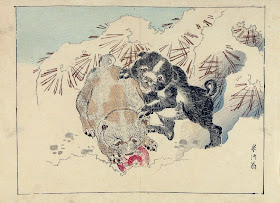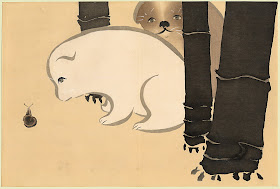This is a support blog for Ainur Elmgren's comic Goldenbird, containing background information, historical research, philosophical musings, etc.
2009/03/12
2009/03/10
Even more Japanese doggies
All black and white, of course. I'm beginning to think that the colour combination has a deeper meaning. Some of the doggies look like inuhariko (lucky papier mache dogs). Please click the picture for more information.
More Japanese Puppies
***
As a fan of black-and-white Japanese dogs, I was thrilled to find these images.
As a fan of black-and-white Japanese dogs, I was thrilled to find these images.

Cover of the Legend of the Eight Dog Warriors (Nansou Satomi Hakkenden), epic Japanese novel written in the period 1814-1842. (Image source)
The dog theme derives from the origin myth of the eight warriors; besieged by his enemies, warlord Satomi promises his daughter Fuse-hime in marriage to the warrior who can break the siege and bring him the head of his enemy. His faithful dog Yatsufusa obeys. In the strange marriage, Fuse-hime remains a virgin but becomes miraculously pregnant. Mortally ashamed, she kills herself, but her eight sons' (puppies?) spirits fill the jewel beads of her rosary and disappear. Eventually, the sons of Fuse-hime are born of human parents around the country, and the novel tells the story of their exploits and final reunion.
 Yatsufusa and Fuse-hime. (Source)
Yatsufusa and Fuse-hime. (Source)Edit. The dog's name, Yatsufusa (八房), means literally "eight spots". According to the novel, he was reared by a tanuki (raccoon dog, a badger-like canine with a reputation for supernatural mischief) in the village of Inugake in the Minamiboso area. Tourists can visit important locations of the novel as if it were historical fact; there is even a memorial for Yatsufusa and the tanuki (read about the Hakkenden tour in English and Japanese).
2009/03/02
Ukiyo-e Puppies
One of Goldenbird's most popular characters (if not THE most popular ever) is Mochi, a little (though she seems to be growing at an alarming speed) puppy of shady Japanese origin.
Mochi is a 10-week-old Akita-ken (秋田犬), precocious and cheerful but also very sensitive. The Akita breed has a complicated history; back in the 1910-20's, it didn't exist in the shape as we know it today. Mochi's black-and-white colouring is evidence of that. Today, the Japanese breed standards exclude white dogs with black markings (pinto). This was not the case 100 years ago. There was no breed standard - but there was a growing notion of the Akita dog as an uniquely Japanese breed that deserved to be preserved. In 1931, the Akita-ken was declared a natural monument. The first official breed standard wasn't published until 1934.

The large hunting dogs of the Akita prefecture had attracted the attention of the Meiji emperor. In a famous and widely spread photograph, two Akita dogs are presented to the emperor. Both are black with white markings or vice-versa. This colouring was later judged to be un-Japanese, as a result of interbreeding with large, imported dogs from Europe and probably also China and Korea. Interestingly, recent studies on the dog genome have shown that the Akita, in spite of being a modern "reconstruction", retains ancient genetic material which makes it unique among breeds.
The group of 14 "ancient" breeds defined by this study includes mainly East Asian dogs such as the Shiba, the Chow, the Shar-Pei and the Siberian husky, which makes me believe that the "foreign" heritage in the Akita could be East Asian rather than European. Indeed, Tatsuo Kimura mentions in his "History of the Akita Dog" that as early as "A.D. 358, black pinto dogs resembling Japanese dogs of today are said to have come from Korea". "Ancient breeds" are human constructions - the natural state of dogs is to have puppies with any available and fit mate. The back-breeding of the 20th century Akita to an idealized primitive state is an impossible project. The result is certainly an attractive dog, but it is not any more authentic than the discarded bloodlines.
Old woodcuts from the Edo period and the Meiji era show that Japanese artists found pinto dogs attractive and worthy of depiction. These puppies are not necessarily Akitas; there are several smaller spitz-type breeds in more southern parts of Japan, such as the Shiba-ken and the Shikoku-ken, which might have been available as models.

Puppies by Hokusai Katsushika

A Winter Scene by Chikanobu (1890)

Playful Puppies by Kawanabe Kyosai (1831-1889)

Two Puppies Playing by Koga Iijima (1900)

Yoshioka Ichimisai’s daughter Sono (from the series Twenty-four Paragons of Filial Piety of Our Country) by Kuniyoshi (1842-1843) (See the Kuniyoshi Project)

Mother, Child and Pups by Utamaro (1753-1806)

Puppy Playing With Geta (EDIT: at closer inspection it appears to be a zori) by Seiho Takeuchi (1906)

Puppies and Snail by Sekka Kamisaka (1909)
These last puppies represent two of the standard colours for Akita-ken today. The third permitted colour is the impressive brindle. The pinto pattern is permitted in the American Akita standard. This breed descends from dogs that were imported to North America (and Europe) before the implementation of the modern Japanese standards.
For most people in Japan today, a pinto Akita looks unfamiliar. The black-and-white Akita lives on as a small lucky papier mache figurine: Inuhariko (犬張り子), a gift for expectant mothers and newborn babies. I like to think of Mochi as Mayann's own live inuhariko.
Sources:
Northland Akitas: Akita Learning Center (Lots and lots of interesting information)
The New York Times - Science
Kyototraditions.com
The Daily Yomiuri/Yomiuri Shimbun
Art galleries:
Arts and Designs of Japan
Japan Print Gallery
The Kuniyoshi Project
***